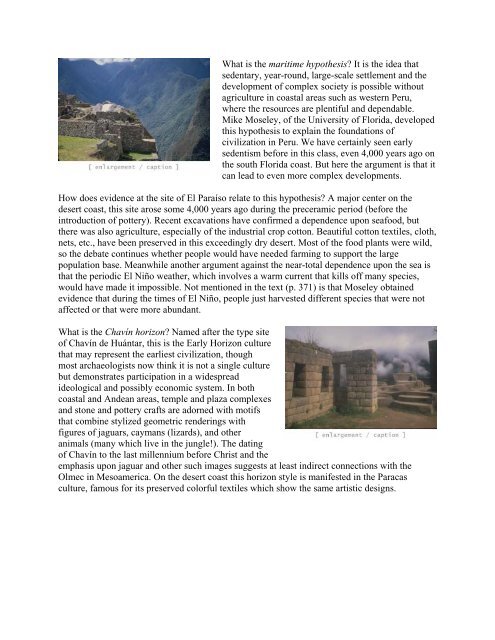INTRODUCTION TO ARCHAEOLOGY Nancy White - Touro Institute
INTRODUCTION TO ARCHAEOLOGY Nancy White - Touro Institute
INTRODUCTION TO ARCHAEOLOGY Nancy White - Touro Institute
You also want an ePaper? Increase the reach of your titles
YUMPU automatically turns print PDFs into web optimized ePapers that Google loves.
What is the maritime hypothesis? It is the idea that<br />
sedentary, year-round, large-scale settlement and the<br />
development of complex society is possible without<br />
agriculture in coastal areas such as western Peru,<br />
where the resources are plentiful and dependable.<br />
Mike Moseley, of the University of Florida, developed<br />
this hypothesis to explain the foundations of<br />
civilization in Peru. We have certainly seen early<br />
sedentism before in this class, even 4,000 years ago on<br />
the south Florida coast. But here the argument is that it<br />
can lead to even more complex developments.<br />
How does evidence at the site of El Paraíso relate to this hypothesis? A major center on the<br />
desert coast, this site arose some 4,000 years ago during the preceramic period (before the<br />
introduction of pottery). Recent excavations have confirmed a dependence upon seafood, but<br />
there was also agriculture, especially of the industrial crop cotton. Beautiful cotton textiles, cloth,<br />
nets, etc., have been preserved in this exceedingly dry desert. Most of the food plants were wild,<br />
so the debate continues whether people would have needed farming to support the large<br />
population base. Meanwhile another argument against the near-total dependence upon the sea is<br />
that the periodic El Niño weather, which involves a warm current that kills off many species,<br />
would have made it impossible. Not mentioned in the text (p. 371) is that Moseley obtained<br />
evidence that during the times of El Niño, people just harvested different species that were not<br />
affected or that were more abundant.<br />
What is the Chavín horizon? Named after<br />
the type site<br />
of Chavín de Huántar, this is the Early Horizon culture<br />
that may represent the earliest civilization, though<br />
most archaeologists now think it is not a single culture<br />
but demonstrates participation in a widespread<br />
ideological and possibly economic system. In both<br />
coastal and Andean areas, temple and plaza complexes<br />
and stone and pottery crafts are adorned with motifs<br />
that combine stylized geometric renderings with<br />
figures of jaguars, caymans (lizards), and other<br />
animals (many which live in the jungle!). The dating<br />
of Chavín to the last millennium before Christ and the<br />
emphasis upon jaguar and other such images suggests at least indirect connections with the<br />
Olmec in Mesoamerica. On the desert coast this horizon style is manifested in the Paracas<br />
culture, famous for its preserved colorful textiles which show the same artistic designs.
















